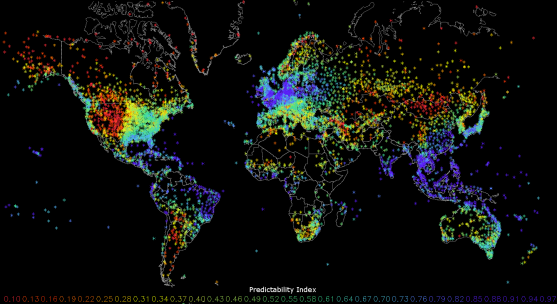The following section gives a summary of a study on global patterns of predictability. This study was conducted by meteoblue to give an overview of the ability of weather models to simulate local temperature and wind speed. The definition of predictability allows users to estimate in advance the precision of a weather simulation for a given place or region.
- Derived multivariate predictability index, using the MOS forecast (model output statistics), which corrects for bias and other local effects.
- The hourly absolute errors of the MOS simulations for temperature, wind speed and dew point are scaled linearly between 0-1.
- Absolute errors for temperature, wind speed and dew point temperature with are considered with equal weight: The scaling bounds for each variable are set, such that the 10 % with largest as well as the 10 % with smallest error have an index value of 0 and 1, respectively.
The predictability index gives a good overview of the ability of numerical models to predict weather variables (independent of local effects).
Predictability (expected quality of simulation) is very variable across the globe
- UK, Northern France, Germany and the tropics are easiest to predict!
- Continental climate is more difficult to predict than maritime (temperature).
- Wind speed predictability is lowest at coastlines.
- Precipitation was not analysed (in this study): but it is most difficult in Tropics.
Predictability index allows for a clear differentiation between the regions
- Regional indices can be assigned to define expected simulation accuracy.
Recommendations
NMMb can be used to generate high precision weather simulations with precision slightly higher than existing global models (GFS), and additionally offers global hourly resolution, to better define phenomena such as predictability.
The concept of predictability can be used in economical models, to calculate regional probabilities of forecast accuracy. Applications are possible to
- Forecasts: setting warning thresholds (e.g. chance of frost prediction);
- History and archive: calculating economical impact of weather-based measures (e.g. frequency of occurrence of certain temperatures, wind speeds, etc.).
NMMb hourly global simulations are now available from 1994 to 2014, and can be used to reproduce weather conditions in any part of the world with a known accuracy.




